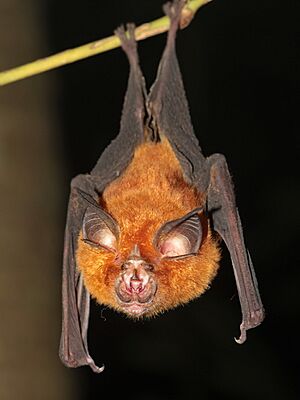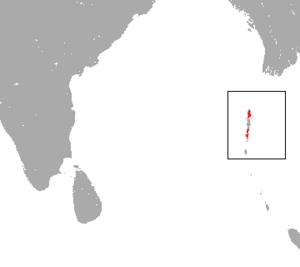Andaman horseshoe bat facts for kids
Quick facts for kids Andaman horseshoe bat |
|
|---|---|
 |
|
| Conservation status | |
| Scientific classification | |
| Genus: |
Rhinolophus
|
| Species: |
cognatus
|
 |
|
| Andaman horseshoe bat range | |
| Synonyms | |
|
Rhinolophus famulus |
|
The Andaman horseshoe bat (Rhinolophus cognatus) is a special kind of bat that lives only on the Andaman Islands. These islands are located in the Bay of Bengal. This bat is known for its unique nose shape, which looks a bit like a horseshoe. During the day, it likes to sleep in caves, but sometimes it also chooses hollow trees.
Contents
About Its Name
Scientists give every animal a special name to help identify it. The Andaman horseshoe bat was first found by an Italian scientist named Enrico Hillyer Giglioli. He collected a bat in May 1892 in Port Blair on the Andaman Islands.
Later, in 1906, a Danish scientist named Knud Andersen officially described this new bat species. He gave it the scientific name Rhinolophus cognatus.
Bat Family Tree
The group of bats called "horseshoe bats" (Rhinolophus) has many different species. To keep them organized, scientists put similar species into smaller groups. The Andaman horseshoe bat belongs to a group called the pusillus species group.
What It Looks Like
Andaman horseshoe bats have a unique nose structure called a "lancet." Their lancets are long and shaped a bit like a spoon. The sides of this nose part curve inwards.
Their forearm, which is like our lower arm, is about 39 to 39.7 millimeters long. This is roughly 1.5 inches. Their skulls are about 17.2 to 18.6 millimeters long, which is less than an inch. These bats usually live in groups of fewer than 50 individuals.
How It Lives
These bats sometimes share their sleeping spots with other types of bats. They have been seen roosting with species like the Dobson's horseshoe bat and the Pomona roundleaf bat.
In January, some of these bats have been observed in a state of torpor. This is like a short, deep sleep where their body temperature and activity slow down. It helps them save energy when food is scarce. On average, these bats live long enough to have babies for about 7.5 years.
Where It Lives
The Andaman horseshoe bat is found only on the Andaman Islands. It does not live on the nearby Nicobar Islands. These bats can be found at elevations up to about 600 meters (nearly 2,000 feet) above sea level. During the day, they prefer to sleep in caves. However, they sometimes use hollow parts of trees as their homes.
Protecting This Bat
The Andaman horseshoe bat is an endangered species. This means it is in danger of becoming extinct. Scientists noticed in 2013 and 2014 that these bats were missing from some caves where they used to live. This might mean their numbers are going down.
The bat is endangered for a few reasons:
- It lives in a very small area, less than 500 square kilometers (about 193 square miles).
- It is found in fewer than five different locations.
- The number of places where it lives continues to decrease.
Even though India's Wildlife Protection Act, 1972 does not specifically protect this bat, most of its habitat is in protected areas. These are places where human activity is limited to help wildlife. One possible threat to these bats is disturbance from people collecting nests of edible-nest swiftlets, which also live in caves.


